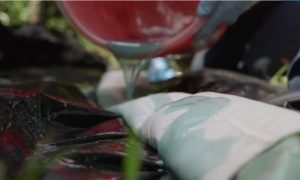Your drain slowed down. A mushy area appears in your backyard. The plumber says it’s a busted drain line. Now that means trenching, or does it? TDT Plumbing has an alternative technology that fixes the leak without digging a trench, and here to explain it all is Gary Gould with TDT Plumbing.
Transcript:
GARY:It does sounds too good to be true. What we do is bring into the home and into people’s backyards technology that’s been out for 30, 40, 50 years, and that’s restoring pipes in place. It’s putting a new pipe in that old pipe. For short, they call it CIPP, cured in place piping.
CHARLIE: It’s been around for 50 years? Where did it start?
Where did Cured In Place Piping start?
GARY: I can’t tell you exactly where it started, but back in the ’70s, rehabbing pipes on a municipal scale, like out in the city street from manhole to a manhole. This is where the idea of fixing existing pipes started. I’m certain that the industrial sector also played a role with using an epoxy coatings and different forms of coatings on pipes to extend the lifetime of these systems. Over the years and in the last 15 or so, the technology has gotten where instead of doing a pipe that’s five-foot in diameter, how to do we deal with something that’s two inches or four or six inches? That’s a big deal. It’s making it small enough and compact it. We can come to your driveway and into your home and restore a pipe. Whereas, 30 years ago, you had to be able to drive a car through the pipe. It had to be so big, and the technologies just weren’t developed yet.
CHARLIE: You’re saying it’s harder to figure out how to do that in a small pipe than in a really big one.
GARY: Right. Because unless you can shrink yourself down to being very, very, very small, everything done within walls, under homes or foundations in buildings has to be done remotely. You’re doing it from an access that is maybe 100 feet away or 300 feet away. It’s a whole different way of making that the technology fit into that environment. Pipes are small, without a doubt. It’s a problem with size.
CHARLIE: This, Gary, is a form of trenchless repair.
GARY: It is a form of trenchless repair, and there’s two or three different ways to deliver that product.
CHARLIE: Right now we’re looking at cured in place pipe repair. How does this work? How does cured in place pipe repair actually work?
How does cured in place pipe repair work?
GARY: The process is simple. Typically we isolate a section of pipe. It is cleaned. It’s video inspected. We look for what’s going on inside. Usually maybe roots are growing into the line. You’ll hear about that from plumbers, “Hey, I got roots in the pipe. It’s causing back-ups.” We clear that stuff out, and then the process is to wet out what looks like a very long sock, and we wet it out with an epoxy resin. We install into that pipe, and then we use a balloon of sorts on the inside of it, and expand and blow the balloon up, and it will allow that new pipe on the inside of the old pipe to harden. Once it hardens, it’s very similar to putting a new PVC pipe into the old original cast iron or concrete type pipe. It might be in your drain line.
CHARLIE: It literally is a pipe within a pipe.
GARY: Absolutely.
CHARLIE: All right. We’re visiting with Gary Gould from TDT Plumbing. They’re experts in leak detection and in place pipe restoration using the epoxy repair method. Also, we’re learning today cured in place pipe repair. Gary, how long does a project like this take?
 GARY: Typically when you’d find in a residential environment, we might spend a half a day or a day. I think what typically happens, we’ll take two, three, maybe four hours preparing the liner, getting it installed, and we allow that to dry for another three or four hours. Then, we remove parts of it, leaving the new pipe in place. For most homes, less than a day, but we have done projects in towers and buildings that may take months of doing a liner a day or a couple of liners per day.
GARY: Typically when you’d find in a residential environment, we might spend a half a day or a day. I think what typically happens, we’ll take two, three, maybe four hours preparing the liner, getting it installed, and we allow that to dry for another three or four hours. Then, we remove parts of it, leaving the new pipe in place. For most homes, less than a day, but we have done projects in towers and buildings that may take months of doing a liner a day or a couple of liners per day.
CHARLIE: That’s important to note that this isn’t just residential. You do this in industrial settings, in multi-family settings, and much larger facilities than maybe even a house.
GARY: Absolutely. It’s a good fit because we can come in and do these things and often while somebody goes to work in the morning. You delivery your product, and then they come back, and they don’t even know that you’ve been there. It’s a good way to rehabilitate existing pipes during the day and keeping things nice and simple.
CHARLIE: Is this right for every kind of drain line? Are there situation where you go out to look at doing cured in place where it just doesn’t work?
Does CIPP work for every job?
GARY: Certainly. There are times depending on the fitting orientation, the system may be so far gone, it’s just passed the point of return of being able to save it. We have to do a little bit up front and investigating and understanding the configurations. Got to have some access to the line, and so at that point we make decisions. Does it make sense to look at a more cost-effective way of … you know, a hybrid. Some conventional repairs and then some CIPP repairs. That’s very common when it comes to plumbing systems and repairing them properly.
CHARLIE: Whether it’s a house, a business or anything. I guess the first step is calling you, and you’re going to send somebody out to evaluate the scene.
GARY: Absolutely. When it comes to sewer and drain lines, a video inspection of the inside of the pipe is critical. We got to really look inside of the fittings and how it’s configured, and map out where it’s at under a home. Often these lines go everywhere, and we just need to be able to say we’re going to do this segment from Point A to Point B, and know where it’s at so that when we come out to do the work, we’re ready to go.
CHARLIE: I imagine part of the savings in this cured in place process, Gary, is that you’re not going to be trenching a yard. You’re not going to have to replace landscaping. You’re not going to have that disruption you would have in trenching. Is the repair itself therefore a lot more cost-effective?
GARY: Often you’re going got see significant cost savings. When you look at for instance, let’s say a 20-foot section of pipe that’s under a house, well I’m here to tell you that an access pit and tunneling or breaking through the concrete foundation and having to tear up floors or carpets or whatever, this can get expensive. Having us come in on a Tuesday morning and removing a commode let’s say in a bathroom and then lining that section of pipe and leaving by that afternoon, you wouldn’t even know that we had been there. You’ve just saved a whole lot of aggravation and downtime, and there’s a lot of savings in that without a doubt. Cosmetic savings is a big thing when it comes to rehabilitating existing pipes.
CHARLIE: TDT Plumbing is a full-service plumbing company if you haven’t figured that out by now. They specialize in leak detection, re-piping, pipe restoration, and of course as you’ve learned today, cured in place pipe repair. Gary, thanks for your time today.
GARY: Thank you, Charlie. Appreciate it.
CHARLIE: Before I forget, be sure to check out that section of their website on cured in place pipe repair for a video showing the process in action. Find that and much more here at tdtplumbing.com.
